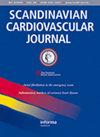非吸烟者血管痉挛性心绞痛患者血浆谷氨酸升高与血浆胱氨酸和抗氧化能力有关
IF 1
4区 医学
Q3 CARDIAC & CARDIOVASCULAR SYSTEMS
引用次数: 1
摘要
抽象目标。氧化应激引起的内皮功能障碍在血管痉挛型心绞痛(VSAP)的发展中起着重要作用。谷氨酸通过产生氧化应激导致内皮功能障碍,并通过胱氨酸/谷氨酸反向转运蛋白(XC-)抑制胱氨酸输入内皮细胞,从而导致抗氧化剂谷胱甘肽的耗竭。然而,谷氨酸和胱氨酸是否参与VSAP的发病机制尚不清楚。我们研究了非吸烟者VSAP患者的血浆谷氨酸和胱氨酸水平、氧化应激标志物和抗氧化能力,以确定谷氨酸和胱胺酸是否与VSAP的发展有关。我们评估了49名非吸烟者,他们被分为(n = 27)和不带(n = 22)VSAP,还测量了血浆谷氨酸、胱氨酸、硝基酪氨酸、活性氧代谢产物和生物抗氧化潜力。后果有VSAP和无VSAP组的血浆谷氨酸和胱氨酸值显著高于无VSAP的组(59.8 ± 25.7对43.5 ± 18.7 µmol/L,p = .016和35.3 ± 14.2对25.2 ± 9.1 µmol/L,p = .0056)。血浆谷氨酸和胱氨酸值显著正相关(r = 0.32,p = .027)。氧化应激标志物硝基酪氨酸和活性氧代谢产物的水平,以及作为抗氧化能力衡量标准的生物抗氧化潜力,在两组之间没有显著差异。然而,谷氨酸和生物抗氧化潜能值显著负相关(r = −0.3,p = .036)。结论不吸烟的VSAP患者血浆谷氨酸水平升高,与血浆胱氨酸呈正相关,与生物抗氧化潜能水平呈负相关。本文章由计算机程序翻译,如有差异,请以英文原文为准。
Increased plasma glutamate in non-smokers with vasospastic angina pectoris is associated with plasma cystine and antioxidant capacity
Abstract Objectives. Endothelial dysfunction caused by oxidative stress plays an important role in the development of vasospastic angina pectoris (VSAP). Glutamate causes endothelial dysfunction by generating oxidative stress, and it inhibits cystine import into endothelial cells via the cystine/glutamate antiporter (XC –), which leads to depletion of antioxidant glutathione. However, whether glutamate and cystine are implicated in the pathogenesis of VSAP remains unclear. We investigated plasma glutamate and cystine levels, oxidative stress markers and antioxidant capacity in non-smoker patients with VSAP to determine whether glutamate and cystine are associated with the development of VSAP. We assessed 49 non-smokers assigned to groups with (n = 27) and without (n = 22) VSAP, and also measured plasma glutamate, cystine, nitrotyrosine, reactive oxygen metabolites and biological antioxidant potential. Results. Plasma glutamate and cystine values were significantly higher in the group with, than without VSAP (59.8 ± 25.7 vs. 43.5 ± 18.7 µmol/L, p = .016 and 35.3 ± 14.2 vs. 25.2 ± 9.1 µmol/L, p = .0056, respectively). Plasma glutamate and cystine values were significantly and positively associated (r = 0.32, p = .027). Levels of the oxidative stress markers nitrotyrosine and reactive oxygen metabolites, and biological antioxidant potential of as a measure of antioxidant capacity, did not significantly differ between the two groups. However, glutamate and biological antioxidant potential values were significantly and negatively associated (r = −0.3, p = .036). Conclusion. Plasma glutamate levels were increased in patients with VSAP who did not smoke, and they were positively associated with plasma cystine and negatively associated with the biological antioxidant potential levels.
求助全文
通过发布文献求助,成功后即可免费获取论文全文。
去求助
来源期刊

Scandinavian Cardiovascular Journal
医学-心血管系统
CiteScore
3.40
自引率
0.00%
发文量
56
审稿时长
6-12 weeks
期刊介绍:
The principal aim of Scandinavian Cardiovascular Journal is to promote cardiovascular research that crosses the borders between disciplines. The journal is a forum for the entire field of cardiovascular research, basic and clinical including:
• Cardiology - Interventional and non-invasive
• Cardiovascular epidemiology
• Cardiovascular anaesthesia and intensive care
• Cardiovascular surgery
• Cardiovascular radiology
• Clinical physiology
• Transplantation of thoracic organs
 求助内容:
求助内容: 应助结果提醒方式:
应助结果提醒方式:


